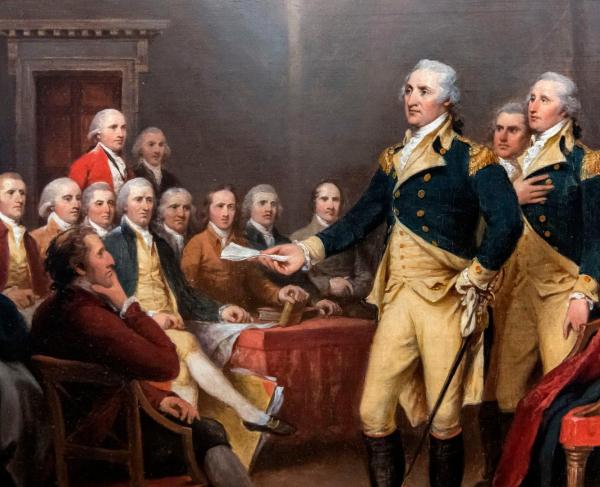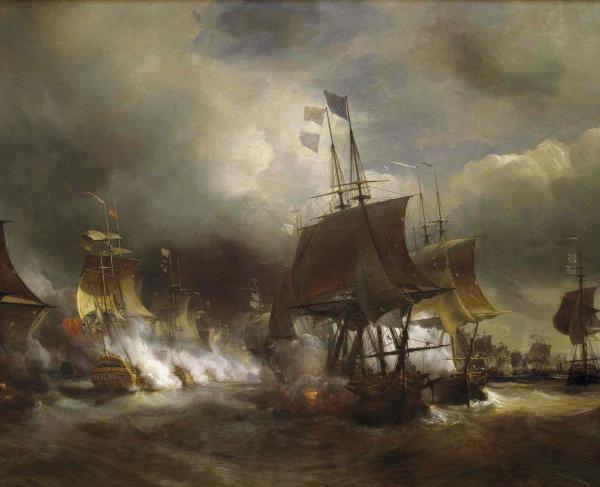
Saratoga Monument, Schuylerville, N.Y.
In 1777, a powerful British army under General John Burgoyne marched south from Canada into New York. Burgoyne hoped to link up with another British army coming up from New York City and cut off the New England colonies, the heart of the American rebellion. Instead, in the fall of 1777, the Americans won a victory at the Battles of Saratoga, and Burgoyne was forced to surrender his army on October 17, 1777. This stunning victory helped to convince France and other European powers to provide critical support to the cause of American independence.
In 1856, a group of patriotic citizens met at the General Schuyler House, which had been burned by the British during the final days of the Saratoga campaign and then rebuilt after Burgoyne’s surrender. This group began to discuss the creation of a monument on the Saratoga battlefield. In 1859, they founded the Saratoga Monument Association (SMA) and received a charter from the New York state government. Among its original trustees and officers was Philip Schuyler, the great-grandson of the Revolutionary War general. The SMA had selected a site for their monument – a spot one mile from where the British surrender took place – when the Civil War broke out. The Saratoga Monument Association was inactive during and immediately after the Civil War, but in 1872 the Association’s secretary, John Corey, revived the organization.
The Association struggled to raise the money needed to build the monument. The New York state government voted to give the Association $50,000 in 1874, but the grant lapsed after two years without being used. The SMA sent petitions to the legislatures of the thirteen original states, asking each one to contribute $5,000, but only Rhode Island responded with a conditional offer of money. The Association hoped to lay the cornerstone of the monument on the centennial of Burgoyne’s surrender, and they were able to obtain $10,000 from the New York state government for that purpose. On October 17, 1877, before a crowd of 40,000 people, the Grand Master of the Freemason’s Grand Lodge of New York laid the cornerstone of the Saratoga Monument. The occasion was marked by a parade that stretched for two miles, which one observer called “the most splendid civic, masonic, and military pageant ever witnessed in northern New York.”
In 1877, a woman named Ellen Hardin Walworth, who had grown up in the Saratoga area, published an account of General Burgoyne’s Saratoga campaign. Horatio Seymour, the President of the Saratoga Monument Association, petitioned the board of trustees to admit Walworth as a member. In 1880, the SMA became the only organization of its kind with a woman trustee. Walworth created and chaired the Committee on Tablets, which helped oversee the creation of interpretation for the site. She would later go on to become one of the founders of the Daughters of the American Revolution.
Construction on the monument proceeded through the late 1870s and into the early 1880s. Most of the funding came from the federal government, which ultimately contributed nearly $100,000 to the project. The monument, a 155-foot granite obelisk, was designed by John C. Markham. Inside the monument, 16 bronze plaques spread across two floors depicted moments from the American Revolution and the Saratoga campaign. Around the outside of the monument were four niches. Three of the niches contain statues: General Horatio Gates faces north towards the route the British army took from Canada, General Philip Schuyler faces east towards his country estate, and Colonel Daniel Morgan faces west towards the positions that his riflemen occupied during the battle. The final niche, facing south, is empty. This was intended to represent Benedict Arnold, whose key role in the Battles of Saratoga was overshadowed by his later betrayal of the American cause.
The capstone of the monument was laid in November 1882, and the three statues were completed in August 1887. The construction of the monument left the SMA with substantial debts, and in 1895 they transferred ownership of the monument and grounds to the New York state government. The monument was officially dedicated on October 17, 1912, the 135th anniversary of the British surrender. The state-operated the monument until May 1980, when it was transferred to the National Park Service. The monument had severe issues with water damage to the stone and metal, and in 1987 the NPS had to close the monument to the public. A $3 million comprehensive rehabilitation began in 1999, and the monument was reopened in 2002. Visitors can climb up nearly 200 stairs to look out over the landscape where one of the pivotal battles of the Revolutionary War took place.
Related Battles
330
1,135



